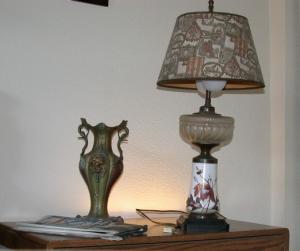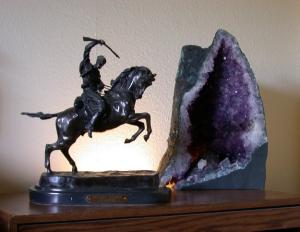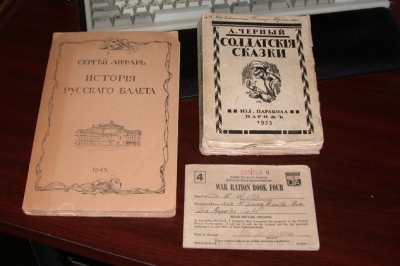by Lazar
Freidgeim
(click on photos to enlarge image)
GARAGE SALE SAGA
Like an orthodox Jew follows his traditions I, too, rise
every Saturday morning as an employee goes to work and get ready
for my good luck hunting, the hunting with an unpredictable
result - I go to garage sales. My company almost never changes
as well as the activity. Two marvellous friends of mine usually
join me. One of them, her name is Alla, I have known since the time we
built sand castles together. And to be more precise, we are the
second generation of family friendship. Alla studied humanities
in Russia, worked in a museum, but she is also a born actress
always thrilled about life and those little surprises hidden in
garage sales. We have been appearing together for so long that
some habituťs of Saturday hunting think we are a married couple.
Acquaintance with the other companion, Irene, who is rather
reserved, doesn't go back that long but is not limited to garage
sales only. Irene became my chief adviser. She even succeeds now
and then in preventing excessive filling of home bins.
Occasionally one more companion - solicitous Lydia joins us.
Garage sales help her to replenish the stock of gifts for her
great-grandchildren who live in Moscow, Russia.
We already know the main features of a flea market and Parisian
book bazaars from wandering through the pages of classical
literature in our school years. Back then I could feel that
special search on my fingertips, I could smell it, I even got an
allergic asthmatic cough from the old book dust. The memory of
Russian war and post-war markets is especially far from romantic.
The sellers so desperately wanted to make some money, they were
always short of, on hardly practical things that we tried to
avoid those spots as much as possible except in case of
necessity.
Flea markets and Swap meets are distinctive American versions of
a second hand market. But a garage sale is a totally different
phenomenon. This buy-sell thing can hardly be called traditional
trade. The prices are normally so low that the profit is not
worth the time spent. But here we deal with American mentality.
Things pile up, become obsolete, on the other hand they are
still too good to be trashed because somebody else can use them.
No second hand store however would accept them, thus the things
are offered on garage sales, sometimes even for free. People
coming to a garage sale for the first time are surprised to see
that sellers do not come together on a designated spot but lay
out their goods in their garage or directly on the lawn in front
of their house. This is a scattered private market. A potential
buyer goes or drives round these places in search of hidden
treasures. Newspapers advertise garage sales; therefore the
route and the methods of search can be planned in advance.
Estate and moving sales are especially interesting. There is
literally everything for sale here, and you might run into
really expensive items.
On garage sales everyone follows their own interests. My friend
Lydia tells me that it is only possible to visit two sales in
one day because you ought not to miss the very beginning -either
8a.m. or 9a.m.- otherwise everything is bought up. But I donít
care when to show up. Things I buy other people donít even
bother to look at. Leaving home I always ask myself: "Well, what
is going to surprise me today - Faberge or Tiffany?" When I find
something nice, the pleasure is similar to that of a hunter, a
fisherman, or a mushroom picker. You can certainly buy fish in
the supermarket. But does it taste the same as the fish caught
with your own hands before dawn?
I am rummaging in a box filled with table service items.
I see an old tablespoon tarnished to blackness and almost grown
with mould. The shape is classically elegant. I take the spoon
out of the box and look closer. "84" solid silver, a
double-headed eagle - the symbol of the supplier of a court yard
of Imperial majesty, and a barely legible inscription whose
meaning can be guessed rather than read: Khlebnikov. Squeamishly
holding the handle, I go to the owner and ask: "How much?"
The lady with no signs of Russian origin tells me the price in a
bashfully apologizing tone: "A quarter." With a happy
face I come to Alla and show her the purchase: "Look, I found
a Khlebnikov spoon for 25 cents!" "As for me, I donít
need any," replies Alla examining a box with jewelry. After
a slight polishing the spoon of the year 1885 appears a brand
new condition as American people say. Even at auctions you
rarely come across products of such a high quality. The
"hunting" has gone right today! Now I enjoy the spoon every day.
I had been always attracted to Old Russian silver. I used to
have a quite good collection in Moscow. Something of a different
kind or updated I pick up here. Lately I have been particularly
interested in silver items with views of Moscow, though there is
very little chance to find them on garage sales. But who knows,
maybe next Saturday?
Collectibles vary a lot depending on their owner. The well-known
Russian opera singer Galina Vishnevskaya collects Russian
miniatures of the 18thth century. One of the most famous ballet
dancers Nureyev had a rich collection of painted or sculpted
male torsos in his apartment in Paris. My friend from
St.-Petersburg possessed a collection of various oil lamps.
Every possible thing can make a collection - clocks, locks, or
samovars, not to mention traditional collectibles such as stamps,
stamped post-cards, baseball cards, etc. I am acquainted with a
man in San Diego who collects items nobody knows how to use.
Because of indefinite subject of my collections I consider
myself not a collector but rather a rag picker who enjoys
possession of extraordinary old things. These things may have
substantial money value or may have not. But they are supposed
to reflect the time they belong to, the epoch.
There was that sale in a Los Angeles
apartment where I saw an electric lamp very much
alike the design of an oil lamp. The owner had asked
five dollars for that but according to garage sales
tradition I acquired the lamp for $3. On a bronze
base there was a flawless porcelain mount hand
painted a la Art Nouveau. A glass vase as if a
container for kerosene (petroleum) was consolidated
on the mount. Such imitations of old things were
very common in the early stage of transition from
old to new. Thus the basic design of the first
automobiles resembled old carriages. Coming back to
my lamp, its entire initial, akin, armature remained
intact, and even the wire and the plug were in
working condition. The plug consisted of two flat
spiral V-shaped pins and bore the patent number
dating back to 1880s.
Not bad at all for a desk lamp! Certainly I learned
all those details later while studying the lamp at
home. But my intuition had worked at the first
glance.
|
 |
 |
On the moving sale in quite modern apartment
I saw a bronze sculpture on a glass shelf. Not too
big but fairly heavy, it reminded me of the style of
Russian masters of the 19th century. A horseman
holding a gun was pictured in a very dynamic
posture. The perfectly sculpted details up to the
forged reins. The inscription on the mount said: 'Made
by Lancere'. His works are exhibited in the museums
of Paris and Moscow, as well as in the best private
collections. I had to pay the fixed price - 75
dollars. After a while I watched the Antique Road
Show displaying among other things a sculpture from
the same series of male and female Cossacks made by
Lancere in the years 1870-80s.
Its estimated auction price was five to six thousand
dollars. A good investment as appraisers say! It is
well known that the lower the price the more time is
needed for search. And the lovelier the result...
|
You may think that only Russian bait works for this
fisherman? By no means! When it comes to good old things I am a
hundred percent cosmopolitan. On a regular garage sale I see
something elegant. A metal handle with a built-in transparent
semi cylinder. Very beautiful, but what is this? But does it
really matter? I come to the owner sitting aside. The
traditional dialogue: "How much?" - "One dollar."
I pay, the thing is mine now. But I cannot help my curiosity: "What
is this?" The owner replies: "I donít know. I donít know
why it has been bought." And after pausing a second he adds:
"I donít know why you bought it." I come home, scratch my
nape and have a closer look at the purchase. The very fine font
on the rim says: "Tiffany & CO Makers. Sterling". The product is
one of the most valued American companies. The strange thing
turned out to be unique and useful - it was a magnifying reading
strip. When placed on a text the transparent semi cylinder - the
lens - covers several lines entirely, so that it is more helpful
than a usual magnifying glass. Well, let me reiterate: but again
(I hope you remember) - it is not merely utility that counts.
One warm California night I had a weird dream. I was a guide
in my private museum for my valued guests. The exhibits varied
immensely, they could not be classified by time or place of
manufacture, by material used, or by their purpose. But there
was one common thing about them - every piece was one of a kind,
and the illogical logic so typical for dreams reflected
precisely the random search for unique antiques.
A sunny morning, a green lawn in front of a house. A couple of
fine china cups sitting in a box and partially wrapped in
news papers catch my eyes. Usually we have to hurry up to visit
as many bazaars as possible, but here we need to slow down and
stop. We carefully examine the entire box and find an almost
complete coffee set - seven cups with saucers and six cake
plates. A fine hand painting, a flawless condition. Irene,
excited about the coming deal passionately inquires for the
price (in plain English she is bargaining). A few minutes later
I pay thirty dollars, and we carefully wrap every piece in the
same old newspaper. The fans of the "hunting" who happen to
witness the deal shrug their shoulders with surprise: Is it
possible to pay that much money on a garage sale? Now the set
placed in the china cabinet pleases my eyes. The cups have only
one inconvenience: they are so delicate that they can be touched
by hands or with lips with great caution. When I showed the set
to an antique dealer, whom I happen to I know, he told me that
was not one of the kind but still a very good handiwork from the
years 1920-1930s, appraisable at 50 to 60 dollars for each cup
with a saucer.
Americans do not have a very long history. Things made in
1940-1950 appear ancient to Americans. Showing such an item the
owner would respectfully tell you: "This is antique, itís
Retro." The European mentality draws the line between truly
antique and new at about the end of the 19th century or
associates the new era with 1917, the year of the Russian
revolution. Occasionally, though, we say about the things not
made in archaic times - this is a real rarity.
The search on garage sales is a "terra
incognita", which name cannot be pre-guessed.
Once I was in West Hollywood and came across a
yellowed cardboard booklet the size of a quarter
page with various coupons inside, part of them had
been already cut out. The cover said: WAR RATION
BOOK FOUR. After some confusion I realized that I
was holding American ration coupons from 1944. The
Russian immigrants who survived in the war with
Germany are often surprised to hear that most
Americans are poorly educated about basic events of
World War II. But at that moment I felt ashamed of
my prejudice that Americans had not confronted the
hardship of wartime. Now, 60 years after the war, I
have, in addition to Soviet ration coupons and other
material evidence of those evil years, an American
ration booklet, even with an address on it, the
address which had not been changed in 60 years.
|
 |
My hands often itch to buy old typewriters. Sometimes I find
a specimen which I can hardly associate with a typical typewriter.
Or old hand operated sewing machines. Or aesthetically enjoyable
Art Nouveau and Art Deco books. Unfortunately I am limited by my
living conditions; there is just no room for all that. I almost
can hear a reproach of some retirees not involved in the mania
of collecting: "We would like to have his worries." And indeed,
this passion is not crucial for living at all. But I appreciate
this lovely side of American every day life with great pleasure.
Another Saturday is coming. Will it be Faberge or Tiffany this
time?
Lazar Freidgeim
- 2009 -
English version translated by Lydia Aleksev
|
 |
ABOUT THE AUTHOR
Lazar Freidgeim, engineer, research fellow. He was
born in Moscow, the capital of Russia, and has lived
there most of his life. Since 1991 he lives in
California (USA). In 2003 - retired - he began to
publish his articles and essays in magazines,
newspapers and online. His hobby is collecting old
Sterling silver, mainly from Russia. His main
interest is silver with images of architectural
monuments of Moscow.
|
|
|
 ASSOCIATION OF SMALL COLLECTORS OF ANTIQUE SILVER
ASSOCIATION OF SMALL COLLECTORS OF ANTIQUE SILVER ASSOCIATION OF SMALL COLLECTORS OF ANTIQUE SILVER
ASSOCIATION OF SMALL COLLECTORS OF ANTIQUE SILVER